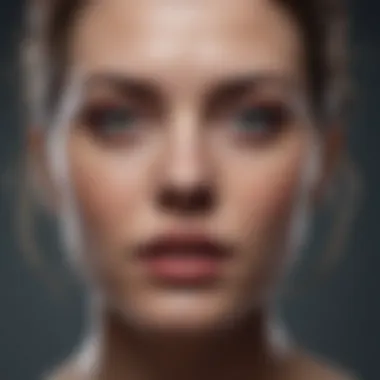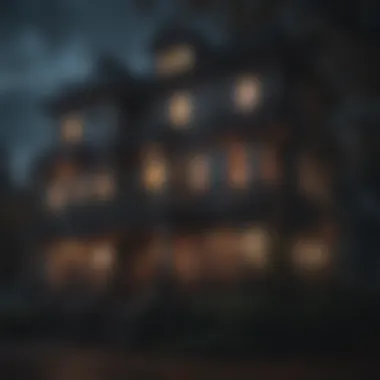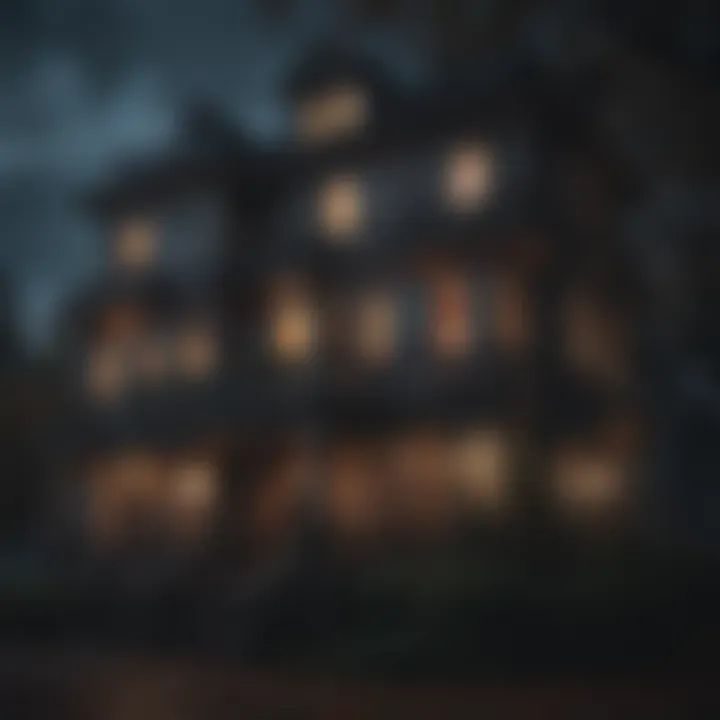Curated Horror Movie Recommendations for Aficionados


Intro
Horror cinema occupies a unique position in film history, providing audiences with experiences that evoke a spectrum of emotions. The genre not only serves as a platform for entertainment but also reflects societal fears and cultural anxieties. By examining various sub-genres such as psychological thrillers, supernatural horror, and slasher films, one can uncover the multifaceted nature of horror movies.
Understanding the characteristics of each sub-genre enriches the viewing experience. Some viewers prefer the tension of psychological horror, while others are drawn to the supernatural elements found in ghost stories. This article aims to dissect the elements that make horror films appealing to different audiences, guiding readers in their selection process.
Key Points to Explore:
- An overview of significant horror sub-genres.
- Insights into thematic elements and cultural contexts.
- Importance of directorial vision and production techniques.
- Recommendations based on viewer preferences.
The exploration begins with a focus on directorial approaches that shape the narrative and aesthetic of horror films. These directors often transgress conventional barriers, allowing audiences to grapple with complex themes.
As we journey through this curated selection, the goal is to elevate your cinematic experience. Choosing the right horror movie can transform a passive viewing into an engaging examination of fears, inhibitions, and societal reflections. Thus, we invite you to delve deeper into the spectrum of horror cinema, ready to enhance your understanding and enjoyment.
Understanding Horror as a Genre
The horror genre serves as a unique prism through which audiences can explore the darker facets of human experience. It holds great significance in the cinematic landscape and offers invaluable insights into societal fears and psychological undercurrents. Understanding horror as a genre involves delving into its evolution, examining its key elements, and recognizing the cultural influences that shape its narratives. This section sets the stage for deeper engagement with horror films, equipping viewers to make informed choices that match their preferences.
The Evolution of Horror Cinema
Horror cinema has a rich and varied history that has evolved significantly over the decades. Initially rooted in folklore and myth, the genre began taking shape with early silent films like 'The Cabinet of Dr. Caligari' in 1920, which introduced psychological elements and the concept of unsettling visuals. The introduction of sound with films such as 'Dracula' in 1931 deepened the genre's impact, allowing for more immersive storytelling.
After World War II, horror films started to reflect societal anxieties, particularly during the Cold War. Monsters became metaphors for societal fears, evident in films like 'Godzilla' in 1954, which explored nuclear paranoia. The 1970s marked another pivotal shift with films like 'The Exorcist' and 'Halloween,' which popularized the slasher sub-genre and the psychological thriller. In recent years, the revival of indie horror has opened doors to innovative narratives that blur the lines between genre conventions.
Key Elements of Horror Films
Horror films typically hinge on several key elements that transform ordinary situations into experiences filled with tension and dread. These characteristics include:
- Atmosphere: The mood is crucial in establishing fear, often achieved through ominous settings and sound design.
- Suspense and Tension: Effective pacing and build-up enhance viewer anticipation and engagement.
- Character Development: Protagonists often face fear-inducing challenges, enabling viewers to connect with their emotions.
- Themes: Common horror themes include isolation, betrayal, and the confrontation of mortality. These themes resonate deeply, often spurring personal reflection.
- Symbolism: Horror films use symbols to convey deeper meanings, inviting audiences to think critically about the narrative.
Incorporating these elements allows horror films to evoke genuine fear and provoke thought, making them more than just entertainment.
Cultural Influences on Horror
Cultural contexts play a crucial role in shaping horror films. They reflect collective fears and societal issues, often drawing from mythological roots and real-world events. For instance, the 1980s saw the emergence of slashers, influenced by changing attitudes towards gender, morality, and violence. In contrast, films like 'Get Out' in 2017 provide commentary on race relations, using horror as a lens to critique societal norms.
The globalization of horror has further diversified the genre. With films like 'Ringu' from Japan and 'Parasite' from South Korea gaining international acclaim, audiences can engage with a variety of narratives that encompass global fears and experiences. As cultural dialogue continues to evolve, horror cinema will likely reflect contemporary issues, further enriching its narrative potential.
"Horror is not a genre just of fear, but of reflection and exploration into what frightens us most."
Identifying Sub-genres
Understanding the sub-genres of horror is essential for anyone who wishes to navigate this vast genre effectively. Each sub-genre has its unique characteristics and appeals, impacting the viewer's experience. By identifying these categories, one can ensure they pick a film that matches their mood, themes of interest, or specific fears. This article delves into the most prominent horror sub-genres, providing insights and recommendations for each.
Psychological Horror
Psychological horror films delve into the human psyche, often blurring the lines between reality and illusion. These films create an unsettling atmosphere through mental anguish, paranoia, and existential dread. Notable examples include "Black Swan" and "The Babadook."
In these films, the horror is not derived from external sources but rather from internal conflicts. The lack of graphical violence in psychological horror can evoke stronger emotional reactions, making them particularly effective for viewers who appreciate depth in storytelling and character development.
When seeking psychological horror, look for elements that explore fear, identity, and human relationships. The pacing is often slower, emphasizing build-up rather than immediate scares. This can create a more menacing sense of dread that lingers long after the film ends.
Supernatural Horror


Supernatural horror involves elements beyond the natural laws of reality, such as ghosts, demons, and otherworldly beings. These films often draw from folklore or mythological sources. Classics like "The Exorcist" and recent hits like "Hereditary" showcase how the supernatural can create palpable terror.
The allure of supernatural horror lies in its ability to challenge our understanding of what is possible. It provides a sense of escapism, yet it often reflects real-life fears, such as the unknown or death. When choosing supernatural horror, consider how the film intertwines personal struggles with these broader themes.
Slasher Films
Slasher films are characterized by a killer stalking and brutally murdering a group of people, typically through well-known tropes of the genre. Titles like "Halloween" and "A Nightmare on Elm Street" exemplify this style. Slasher films often appeal to those who enjoy a more visceral experience, combining suspense with occasional gore.
These films frequently explore themes of morality and punishment, often punishing characters for societal transgressions. While they can be formulaic, the creativity in the kills or character development often elevates the experience. Slasher films are known for their iconic villains, and the genre can be an entertaining choice for those welcoming a thrilling ride.
Found Footage Horror
Found footage horror relies on the premise that the film is discovered footage from fictional sources like video cameras or smartphones. This style creates an immersive experience, drawing viewers into the story more intimately. Films like "The Blair Witch Project" and "Paranormal Activity" have popularized this approach.
The strength of found footage lies in its naturalistic style, making the horror feel more real and immediate. This sub-genre may not be suited for everyone; some viewers find the camera work disorienting. However, found footage films often excel in building atmosphere and tension, providing a different viewing experience.
Body Horror
Body horror explores the grotesque vulnerabilities of the human body, often showcasing transformation, deformity, or mutilation. Films like "The Fly" and "Tusk" exemplify this sub-genre's unsettling narrative. The focus here is on the physical form, challenging ideals of beauty and health.
Body horror serves as a metaphor for fear of disease, aging, or bodily autonomy. The disfigurement and transformation depicted can provoke visceral reactions, making viewers reflect on their own bodies. This sub-genre invites those interested in deeper themes regarding self-identity and societal expectations.
"Horror films reflect societal fears; understanding sub-genres helps tailor your viewing experience to those fears."
Recommendations by Sub-genre
The classification of horror films into sub-genres is crucial in guiding viewers toward appropriate choices that align with their preferences. Each sub-genre offers unique themes, narrative techniques, and emotional responses. By understanding these distinctions, audiences can enhance their viewing experience, ensuring they find films that resonate with their individual tastes and emotional landscapes. Furthermore, the appeal of different sub-genres often draws from historical, cultural, and psychological influences, making it an essential area of exploration.
Top Psychological Horror Films
Film Analysis: Themes and Techniques
Psychological horror focuses on the inner workings of the mind, using tension and suspense rather than overt violence. This approach often leaves the audience questioning reality and their interpretations of the characters' motivations. Films in this sub-genre typically explore themes such as paranoia, identity crisis, and the effects of trauma. A prime example is The Shining, where the isolation of the characters correlates with their deteriorating mental states.
The benefit of psychological horror lies in its ability to create a profound emotional impact. It engages viewers intellectually, encouraging them to delve into the complexities of the narrative. One unique feature is its reliance on subtlety, allowing viewers to interpret the horror without explicit depictions. However, this style may not satisfy audiences seeking immediate scares, which can be a disadvantage for some viewers.
Directors to Watch
Prominent directors in the psychological horror realm, such as Alfred Hitchcock and Ari Aster, have significantly shaped this sub-genre. Hitchcock's mastery of suspense and character development is evident in films like Psycho, where the unsettling narrative unfolds through a focus on human psychology.
Focusing on directors is beneficial because their vision and style can deeply influence the films they create. Their unique approaches contribute to the overall impact of their work. Notably, directors like Jordan Peele, with an emphasis on societal critique and racial themes as seen in Get Out, present fresh perspectives. However, the popularity of specific directors may not align with all audience preferences, indicating a potential pitfall when recommending films based solely on their directorial choices.
Noteworthy Supernatural Horror Movies
Iconic Films and Their Impact
Supernatural horror films often delve into the realm of the unknown, utilizing elements like ghosts, demons, and otherworldly forces to frighten viewers. Movies like The Exorcist have left significant marks in cinematic history, influencing not only the horror genre but also broader popular culture.
The importance of iconic films lies in their cultural impact and lasting influence on subsequent works. These movies also establish conventions and tropes that define the sub-genre, offering a lens through which to view societal fears. A downside, however, is that iconic films may overshadow newer works, potentially leading to a narrower appreciation of contemporary supernatural horror.
Modern Takes on the Supernatural
In recent years, filmmakers have reinvented supernatural horror, adapting it to modern contexts. Films like Hereditary and The Conjuring have brought fresh narratives and advanced cinematographic techniques that elevate the tension and terror. These modern takes often reflect contemporary fears, such as family dynamics and societal anxieties, making them relevant to today’s audience.


The evolution of the supernatural genre showcases innovation in storytelling and special effects, which can enhance viewer engagement. However, this constant need for innovation may alienate traditional horror fans who prefer the classic styles.
Essential Slasher Films
Origins of the Slasher Genre
The slasher genre is marked by its focus on a killer who stalks and murders a group of people, often using gruesome methods. Films like Halloween and Friday the 13th are foundational to this genre, establishing key elements such as the final girl trope and suspenseful chase sequences. Understanding its origins helps viewers appreciate the genre's evolution and lasting appeal.
The origins of this genre are tied to the cultural fears of the time, reflecting societal anxieties through its narratives. It also presents a clear structure that many viewers find satisfying. However, slasher films can sometimes lean toward formulaic plotting, which may diminish their unique appeal for some audiences.
Influential Characters
Iconic characters such as Michael Myers and Freddy Krueger have become symbols of the slasher genre. Their distinctive features and backstories resonate with audiences and contribute significantly to the genre's overall identity. The portrayal of these characters often reflects deeper psychological themes, making them memorable beyond their homicidal traits.
Highlighting influential characters is beneficial as they serve as cultural touchstones within horror. However, focusing too much on character can risk overshadowing the film's broader themes, which viewers may also want to engage with.
Critically Acclaimed Found Footage Films
Technique and Storytelling
Found footage horror films utilize a unique storytelling technique that presents the narrative as if the footage is discovered material. This style can create a sense of realism and immediacy, pulling viewers directly into the action. Films like Paranormal Activity demonstrate this technique's effectiveness in eliciting fear through everyday settings and situations.
The unique feature of found footage is its ability to enhance audience immersion, making the horror feel more relatable. Although this technique has its merits, it can also lead to a sense of repetitiveness if overused, which might alienate certain viewers.
Viewer Reception and Critique
Viewer reception of found footage films often hinges on their ability to maintain suspense and believability. Films in this category tend to attract polarized opinions; some find the style refreshing while others may criticize it for its production value. Audience engagement varies widely, which can dictate the film's success in the market.
Understanding viewer reception is essential as it informs filmmakers about what resonates with audiences, shaping future projects. However, focusing too much on audience opinion can cloud creative vision, leading to films that try too hard to please.
Exploring Body Horror
The Role of Physicality in Horror
Body horror centers on the grotesque and often disturbing transformations of the human body. This sub-genre interrogates the relationship between the physical and psychological, as seen in films like The Fly. It often exposes underlying fears regarding illness, aging, or transformation.
The role of physicality in horror offers a visceral experience that stimulates fear on a bodily level. This connection to the audience can create a profound impact, fostering a deep engagement with the narrative. A potential drawback is that intense imagery may be off-putting for more sensitive viewers, limiting its reach.
Key Films and Their Messages
Body horror films often convey complicated messages about identity and societal fears surrounding the body. Videodrome positions itself as a commentary on media consumption and control, utilizing the horror of physical transformation as a metaphor. This makes the discussion of key films pivotal in understanding hybrid messages within horror.
The combination of horror and thematic depth makes body horror an essential discussion point. However, the explicit nature of the films might deter audiences seeking subtler forms of horror, leading to a narrow appreciation of this sub-genre.
The Role of Direction and Cinematography
In horror cinema, the role of direction and cinematography is significant in shaping the audience's experience. Direction influences not only the storyline but also the emotional cadence of the film. A director's vision can elevate the material by crafting a distinctive atmosphere, enhancing suspense, and facilitating the viewer's connection with the characters. Cinematography, on the other hand, encompasses the visual composition of scenes, the choice of angles, lighting, and camera movement. All these elements work together to build tension and provoke fear.
A well-directed horror film often employs a unique narrative structure. This can be seen in how directors develop pacing and tension, leading to climactic moments that resonate with the viewer. Horror is not merely about jump scares; rather, it thrives on atmosphere and psychological engagement. Thus, the choices made during the directing process play a pivotal role in the film's impact.
Influential Directors in Horror


Many directors have left an indelible mark on the horror genre. Alfred Hitchcock is often heralded for his psychological thrillers, blending suspense with intricate storytelling. Films like "Psycho" showcase his ability to manipulate the audience's expectations through innovative techniques. Similarly, John Carpenter's contributions, particularly with "Halloween," revolutionized the slasher format, bringing attention to the soundtrack's role in creating suspense.
Directors like Wes Craven and Tobe Hooper explored more unconventional narratives, pushing boundaries of fear and discomfort. Each of these filmmakers brought their own style and storytelling methods, which inspired subsequent generations. Whether emphasizing realism or abstract horror, their styles endure, demonstrating the varied potential within the genre.
Cinematographic Techniques
Cinematographic techniques are integral to establishing the tone of a horror film. For instance, low lighting and shadow play can create an atmosphere filled with dread. Nothing intensifies fear quite like the unknown lurking in darkness. Moreover, the use of tight framing can elicit feelings of claustrophobia. Incorporating wide shots can amplify a sense of isolation.
Other techniques such as handheld camera work can also enhance realism. This method allows viewers to feel as though they are part of the action, increasing emotional stakes. Color palettes, especially muted or dismal tones, further contribute to a film’s thematic resonance.
Effective use of direction and cinematography not only augments the narrative but also deepens audience engagement, triggering emotional responses that linger long after the credits roll.
Audience Reception and Cultural Significance
The audience reception of horror films plays a crucial role in shaping the cultural landscape and the future of the genre. It is not merely about how a particular movie is reviewed but also about how it resonates with viewers on emotional, psychological, and social levels. This reception reflects broader societal fears and anxieties, making this topic central to the understanding of horror cinema.
Critical Reception of Horror Films
Critical reception discusses how film critics and audiences perceive and respond to horror movies. Many horror films receive mixed or negative reviews from critics when they first release, but later, they gain cult status or critical acclaim. This can be attributed to a range of factors such as marketing, changes in societal norms, and demographic shifts among the viewers.
When critics scrutinize horror films, they often focus on various aspects including direction, cinematographic choices, writing, and acting. The surprising thing is that audience ratings frequently diverge from critical opinions. A film like "The Witch" received polarized reviews, yet it has found a substantial audience who appreciates its atmospheric storytelling and thematic depth.
Another factor is the role of the internet. Social media platforms provide viewers a place to voice their opinions, discuss ideas, and share experiences. This democratizes reception and allows for diverse perspectives. Often, a heightened word-of-mouth effect can elevate a film's status, as seen with films like "Get Out" and "Hereditary."
The Impact of Horror on Society
Horror films have always interacted intimately with the societal issues they arise from. They often reflect the fears, anxieties, and cultural tensions of their respective times, acting as a mirror to society. This impact can be profound. For example, during the Cold War, horror films like "Invasion of the Body Snatchers" captured fears of conformity and loss of identity. Similarly, in the wake of social movements, films such as "Get Out" address racism and the complexities of contemporary life.
Moreover, horror serves a cathartic function for many viewers. Engaging with fearful scenarios in a controlled environment enables individuals to confront their own fears and anxieties. Importantly, the genre has also opened up conversations about mental health, trauma, and identity. It encourages viewers to engage with challenging topics that might otherwise be avoided.
Horror can foster community—a shared experience of fear can bond viewers. The social component of watching horror films has led to retrospective screenings, conventions, and discussions that create spaces for fans to connect over their interests.
"Horror is an effective way for people to explore their deepest fears through a safe lens."
Through this lens, horror gives voice to the marginalized and explores discomforting truths. This positions the genre not just as a form of entertainment, but as an essential cultural artifact that continually evolves with society's zeitgeist.
Epilogue: Choosing the Right Horror Movie
In the expansive realm of horror cinema, the process of selecting a suitable film can be daunting yet rewarding. Understanding how personal preferences and emotional states play into the viewing experience is crucial. This section emphasizes that selecting the right horror movie is not just about finding a title; it also involves aligning the film's themes with one's mood and emotional needs.
Personal Preferences and Mood
Every viewer approaches horror with unique inclinations. Some might seek chilling narratives that provoke deep psychological fear, while others may prefer lighter supernatural fare.
- Identify Your Preferences: Assess whether you enjoy visceral slasher films or prefer the cerebral nature of psychological horror. Identifying your comfort zone can guide you in selecting films that you'll find appealing.
- Consider Your Mood: Your current emotional state greatly influences your movie choice. Feeling adventurous? You might explore a new sub-genre or a classic that challenges norms. Conversely, if you seek comfort, revisiting familiar favorites could provide a fulfilling experience.
- Social Context: The company you keep during your viewing can also alter the experience. Watching a horror movie with friends can heighten the thrill. Assess how the social settings influence your preferences and select movies accordingly.
Horror films can be mirrors reflecting our fears and desires. Therefore, it is helpful to consider what specific aspects you wish to confront or escape. This introspection leads to a more enriching viewing experience.
Exploring New Territory in Horror
Venturing beyond well-trodden paths can broaden understanding and appreciation for the genre. Trying out different sub-genres, directors, or international films can shed light on diverse storytelling approaches and cultural influences.
- Expand Your Horizons: Experiment with films outside your usual choices. For example, if you primarily watch supernatural horror, consider exploring body horror or psychological horror. New narratives can enhance your perspective on societal issues.
- Watch International Films: Foreign horror films often present unique cultural contexts. They might tackle universal fears through their distinct cultural lenses. Titles like Ringu from Japan or [REC] from Spain illustrate how cultural backgrounds shape horror.
- Engage with Emerging Filmmakers: Independent films or new directors often challenge mainstream narratives. Platforms like Reddit or social media can help you discover upcoming voices in horror that push creative boundaries.
The journey of discovering horror films is as significant as the films themselves. Engaging with new narratives and styles cultivates an appreciation for the genre's depth and varied methods of invoking fear.
"Horror is not just a genre; it is a reflection of our fears, desires, and societal issues. The right horror movie can lead to profound insights about ourselves and the world around us."
Ultimately, the process of choosing the right horror movie hinges on a balance of personal preferences and a willingness to explore unfamiliar territory. As horror continues to evolve, staying open to diverse experiences ensures a richer cinematic journey.



